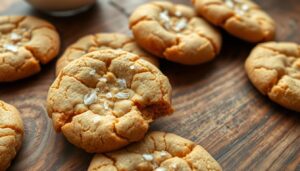Imagine the smell of fresh bread filling your home. It’s like a warm hug. If gluten sensitivities have kept you from homemade bread, this recipe is your ticket back. Baking bread is a labor of love, nourishing you and your family with healthy ingredients.
With just four ingredients, you can make a delicious loaf. This recipe is perfect for anyone, whether you’re experienced or new to baking.
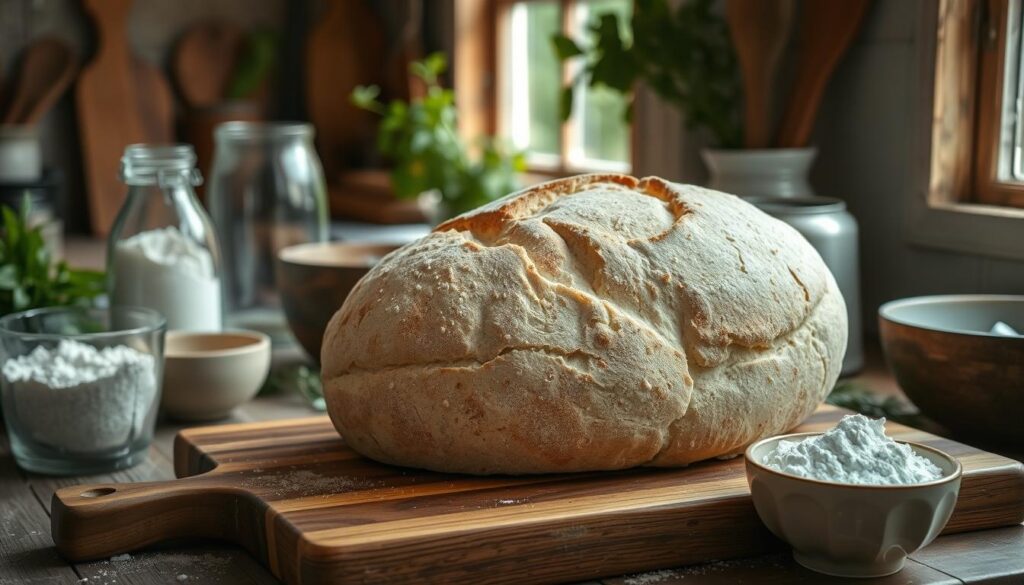
We’ll explore sourdough fermentation, the right ingredients, and how to make your own gluten free sourdough bread. It’s a journey that will make your life better, one slice at a time.
Table of Contents
Key Takeaways
- This gluten free sourdough bread recipe requires only four essential ingredients.
- The recipe does not involve kneading, making it more accessible for novice bakers.
- Fermentation and baking are spread across two days for optimal flavor and texture.
- Bob’s Red Mill Gluten-Free 1:1 Baking Flour is recommended for the best results.
- Allowing the bread to cool for at least four hours prevents a gummy texture.
- This easy gluten free sourdough recipe invites creativity, encouraging modifications to suit your palate.
Introduction to Gluten Free Sourdough Bread
Gluten free sourdough bread is a hit with those who follow a gluten-free diet. It’s not just about meeting dietary needs; it also brings unique tastes and textures. Making a gluten free sourdough loaf is a bit different than traditional sourdough.
Choosing the right ingredients is key to making great gluten free bread. Using flours like brown rice, millet, or quinoa, along with psyllium husk, makes the dough easier to work with. A healthy starter is essential for the right rise and texture.
The fermentation process adds a complex flavor to gluten free sourdough. It makes the bread sour but gentle on your stomach. Trying out different techniques, like proofing and using banneton baskets, can improve your sourdough baking.
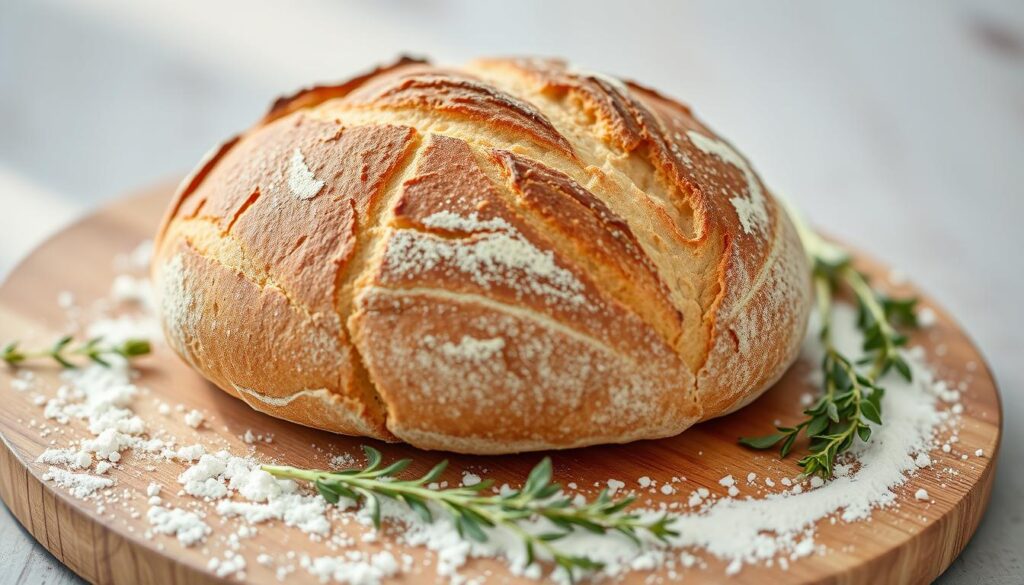
To get a crispy crust and chewy inside, bake your bread at 450°F. Make sure it reaches 209°F inside. After baking, let it cool overnight for the best texture. This way, you can enjoy your gluten free sourdough loaf just right.
Looking for new ideas? Check out a cottage cheese bread recipe for a gluten-free alternative. With practice, you can become a pro at making gluten free sourdough bread. It’s a fun way to enjoy homemade treats.
Understanding Sourdough Fermentation Process
The sourdough fermentation process is a blend of wild yeast and beneficial bacteria. It creates the sourdough’s unique taste and texture. Unlike regular bread, gluten-free sourdough absorbs less gluten, making it better.
Ingredients like organic teff, sorghum, and millet, along with a mature sourdough starter, make this bread special.
What Makes Sourdough Unique?
Sourdough is known for its natural fermentation, which gives it a tangy taste. This process breaks down gluten, making it easier to digest. It’s different from commercial bread.
A sourdough starter, which matures for at least two weeks, is key. It captures the wild yeast needed for fermentation. This creates a bread rich in natural ingredients, offering health benefits.
Health Benefits of Fermentation
Fermentation has many health benefits. It makes the dough easier to digest by breaking down complex carbs. This helps your body absorb nutrients better.
Sourdough is also full of healthy probiotics, which are good for your gut. These probiotics improve digestion. Plus, gluten-free sourdough uses natural ingredients, not commercial yeast.
For a detailed recipe to make this bread, click here. Using a digital kitchen scale for precise measurements is also important for successful fermentation.
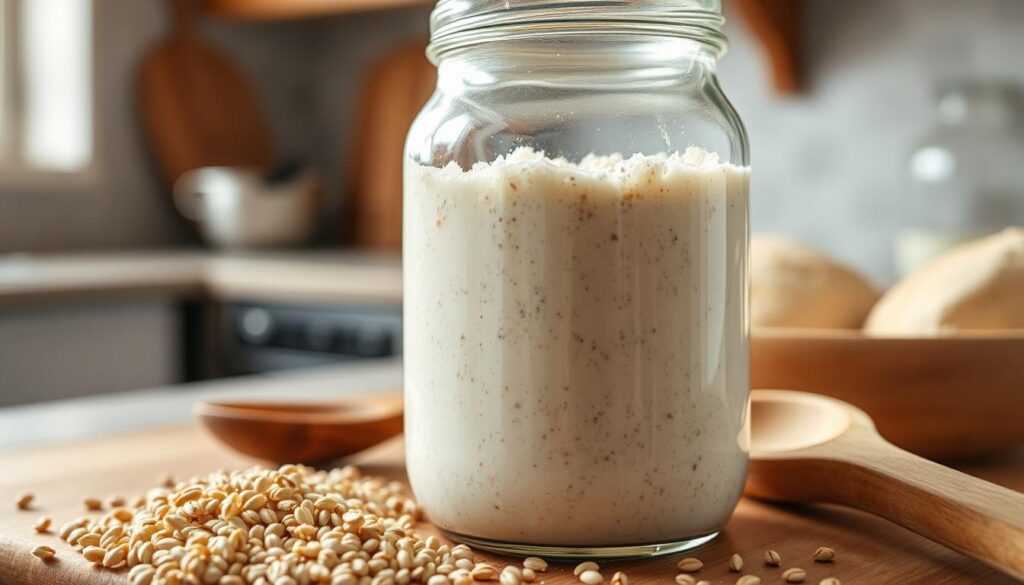
Key Ingredients for Your Gluten Free Sourdough Bread
Making the perfect gluten free sourdough bread starts with the right ingredients. Each part is crucial for the right texture and taste. We’ll look at the key ingredients you need, like the right flour, a good sourdough starter, and more.
Choosing the Right Gluten Free Flour
When baking gluten free sourdough, choosing the right flour is key. Bob’s Red Mill 1:1 Gluten Free Baking Flour is a top pick. It has xanthan gum for a gluten-like feel. Try other blends like King Arthur Measure for Measure or GF Jules to find your favorite.
The Importance of a Good Sourdough Starter
A strong gluten free sourdough starter is vital for a great rise and flavor. It takes time to get your starter going, but it’s worth it. A well-fed starter, left out overnight, adds a tangy taste and a bubbly dough. Use about ¾ cup of starter for the best results.
Other Essential Ingredients
There are more ingredients you need besides flour and starter:
- Warm milk to activate the starter and make the bread tender.
- Unsalted butter for moisture and richness.
- Tapioca starch for better bread texture.
- Xanthan gum for elasticity.
- Kosher salt for flavor.
- Granulated sugar for yeast and browning.
Also, think about adding psyllium husks for better shape. Check out the full recipe for exact amounts and steps. You can find a detailed guide on baking gluten free sourdough bread at this link.
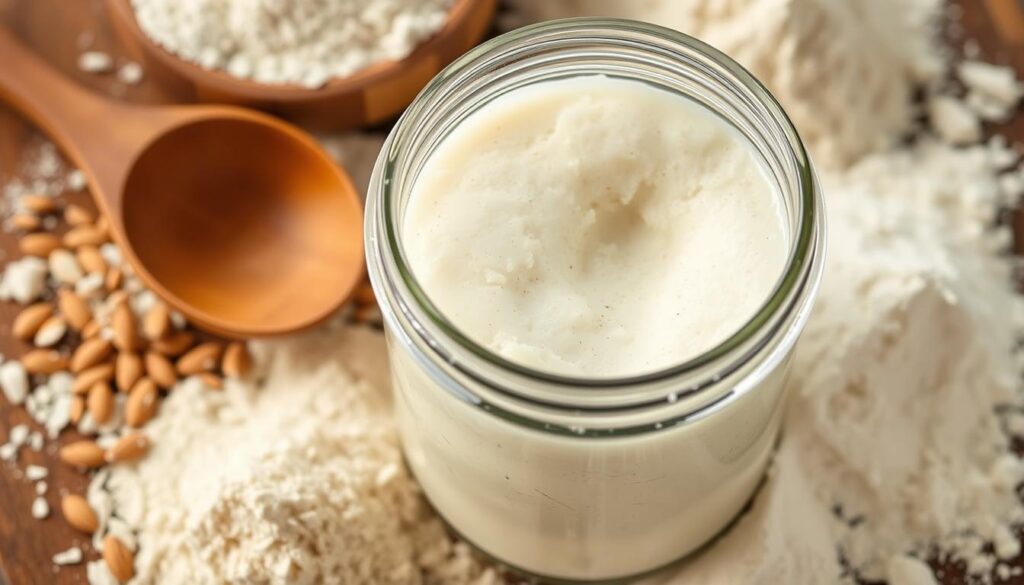
| Ingredient | Quantity | Role |
|---|---|---|
| Gluten-Free Flour Blend | 3 cups (420g) | Base for dough |
| Xanthan Gum | 1 ½ teaspoons | Improves elasticity |
| Tapioca Starch | 9 tablespoons (68g) | Aids texture |
| Granulated Sugar | 2 tablespoons (25g) | Feeds yeast |
| Kosher Salt | 1 ½ teaspoons (9g) | Enhances flavor |
| Gluten-Free Sourdough Starter | ¾ cup (165g) | Leavening agent |
| Warm Milk | 1 ½ cups (12 fluid ounces) | Activates starter |
| Unsalted Butter | 4 tablespoons (56g) | Adds moisture |
Gluten Free Sourdough Bread Recipe
Making gluten free sourdough bread is rewarding. This guide will help you make a tasty loaf. You’ll learn the right timing for each step.
Simple Step-by-Step Guide
Here’s how to make your gluten free sourdough bread:
- Get your ingredients ready: You’ll need ground flax seed, honey, olive oil, apple cider vinegar, and more.
- Measure carefully: Use a digital scale for precise measurements. This is key for a good loaf.
- Mix the wet ingredients: In a bowl, combine water, ground flax seed, sourdough starter, honey, olive oil, and vinegar.
- Combine the dry ingredients: In another bowl, mix brown rice flour, tapioca flour, corn starch, psyllium husks, xanthan gum, salt, and baking powder.
- Blend the mixtures: Mix the wet and dry ingredients until smooth. A stand mixer helps a lot.
- Bulk fermentation: Let the dough sit, covered, for 3-4 hours at room temperature.
- Shape the dough: Put it in a Banneton basket or a bowl safe for high oven temperatures.
- Proofing: Let it proof for 1-2 hours until it rises.
- Baking: Preheat the oven to 375°F (190°C). Bake for 60 minutes, covered, to keep steam in.
Timing Your Baking Schedule
Here’s a schedule to fit your day:
| Activity | Time |
|---|---|
| Mixing Dough | 15 minutes |
| Bulk Fermentation | 3-4 hours |
| Shaping and Proofing | 1-2 hours |
| Baking | 60 minutes |
| Total Time | 5-7 hours (plus resting time) |
Stick to this schedule to manage your time well. After baking, let the bread cool. Then, slice and enjoy your gluten free sourdough.
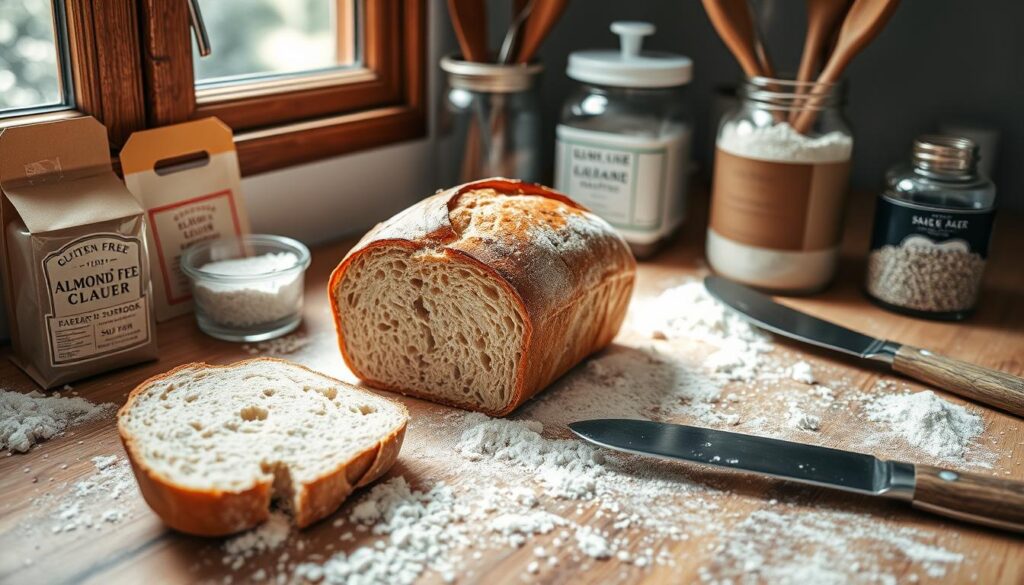
Essential Equipment for Baking Sourdough
Having the right tools is key to baking sourdough. With the right equipment, your sourdough bread will turn out amazing. Don’t just focus on ingredients; the tools you use matter a lot.
Casting a Dutch Oven
A Dutch oven is a must-have for sourdough baking. It ensures even heat and keeps moisture in. This combo is perfect for a crusty boule.
The lid traps steam, which is crucial at the start of baking. It helps create a crispy outside and a soft inside. A Dutch oven can last for years, making it a great investment for bread lovers.
Measuring Tools for Accurate Baking
Getting your measurements right is vital for good baking. A digital kitchen scale is a must-have for under $10. It helps you measure ingredients accurately, leading to better results.
Other tools you should have include:
- Flour Sifters: They aerate and remove lumps from flour.
- Baking Pans/Pots: You need them for shaping and baking your sourdough.
- Bench Scrapers: They’re great for portioning dough and scraping surfaces without adding extra flour.
These tools help you understand and manage the sourdough bread-making process. Also, think about getting proofing baskets and fermentation containers for better dough rise. With these tools, you can improve your baking skills and make delicious gluten-free sourdough bread every time.
| Tool Category | Recommended Tools | Use Percentage |
|---|---|---|
| Measuring Tools | Digital Scale, Flour Sifters | 100% |
| Baking Tools | Dutch Oven, Baking Pans/Pots | 100% |
| Dough Management | Bench Scrapers, Proofing Baskets | 50% |
How to Create Your Gluten Free Sourdough Starter
Starting a gluten free sourdough starter is the first step in baking gluten free sourdough bread. It needs careful attention to ingredients and nurturing over several days. Let’s look at what you need for your starter and how to keep it healthy.
Ingredients for Making Starter
Start with simple ingredients: choose your flour and water wisely. For a gluten free sourdough starter, you can use:
- Brown rice flour
- Sorghum flour
- Teff flour
- Millet flour
- Quinoa flour
- Amaranth flour
On Day 1, mix 50 grams of flour with 60 grams of water. Stir until smooth and keep it warm. From Days 2 to 4, feed your starter with 30 grams of flour and 40 grams of water daily.
Caring for Your Sourdough Starter
Regular care is key for a healthy gluten free sourdough starter. By Day 3, discard most of the starter and feed it with 100 grams of flour and 100 grams of water. Keep this up for a week, adjusting as needed. For frequent baking, feed it every 12 hours.
| Day | Action | Ingredients |
|---|---|---|
| 1 | Mix Ingredients | 50g flour, 60g water |
| 2-4 | Dailies Feed | 30g flour, 40g water |
| 3 | Discard & Feed | 100-120g starter, 100g flour, 100g water |
| 4-7 | Maintain | 100g starter, 100g flour, 100g water |
Remember, patience is crucial when nurturing your gluten free sourdough starter. It takes about 7 days for the yeast to be ready. Watch for signs like bubbles and volume increase. With the right care, your starter will be ready for baking adventures.
Making Your Gluten Free Sourdough Bread
To make perfect gluten free sourdough bread, focus on mixing, proofing, and baking. Each step is key to a great loaf. Follow these steps to master gluten free sourdough bread.
Mixing Your Dough
Start by mixing the ingredients carefully. For this recipe, you’ll need:
- 1 ½ cups Gluten Free Sourdough Starter
- 3 large Eggs
- 4 tablespoons Unsalted Butter, melted
- 1 ¼ cups Milk
- 2 tablespoons Honey
- ¾ cup Sweet Sorghum Flour
- ¾ cup Tapioca Flour
- ½ cup Brown Rice Flour
- ½ cup Potato Starch
- 1 tablespoon Xanthan Gum
- 1 tablespoon Baking Powder
- 2 teaspoons Sea Salt
Use about 470g of water for the best results. This lower hydration helps with texture and rise. Mix well until the dough is consistent.
Proofing Procedures Explained
Proofing is crucial for flavor and texture. Let the dough rest for 1 to 2 hours at room temperature first. Then, refrigerate it for several hours or overnight for better taste.
When baking time comes, let the dough proof again at room temperature for 2 to 3 hours. It should double in size. The time may vary based on your kitchen’s conditions.
Baking Tips for Perfect Crust
For a perfect crust, follow these tips:
- Preheat your oven to 450°F (232°C) before placing the dough inside.
- Bake in a Dutch oven to trap steam for a crusty exterior.
- Use a narrow bread pan for a taller loaf instead of a standard 9″ x 5″ pan.
This bread can last up to five days in a sealed container or a week in an airtight one. Freezing it keeps it fresh for a month. With these tips, you’ll get a deliciously textured loaf.
| Ingredient | Quantity |
|---|---|
| Gluten Free Sourdough Starter | 1 ½ cups |
| Eggs | 3 large |
| Unsalted Butter (melted) | 4 tablespoons |
| Milk | 1 ¼ cups |
| Honey | 2 tablespoons |
| Sweet Sorghum Flour | ¾ cup |
| Tapioca Flour | ¾ cup |
| Brown Rice Flour | ½ cup |
| Potato Starch | ½ cup |
| Xanthan Gum | 1 tablespoon |
| Baking Powder | 1 tablespoon |
| Sea Salt | 2 teaspoons |
Common Challenges in Gluten Free Sourdough Baking
Baking gluten free sourdough bread comes with its own set of challenges. You might face issues like a gummy texture or a dough that doesn’t come together. Knowing these common problems can help you succeed in your baking.
Addressing Gummy Textures
A gummy texture often means your bread isn’t baked long enough. Gluten free dough usually needs more time in the oven. If your bread feels dense and sticky, bake it a bit longer.
Also, choose the right gluten free flour blends. They should help with structure and absorbing moisture. Authentic Foods Steve’s Gluten Free Bread Blend might work better than others.
Tips for the Right Dough Consistency
Getting the dough consistency right is key. If it’s too sticky, it might have too much liquid. Adding more flour can fix this.
Be mindful of the gluten free flour blends you use. They can differ a lot in how much liquid they need. For example, King Arthur Measure for Measure might not work well with yeast.
Use gluten free baking tips to help your bread. Adding binders like xanthan gum or psyllium husk can improve its structure. Watch the fermentation time too; too long can make your bread taste sour and have a bad texture.
By adjusting your techniques based on these tips, you can improve your gluten free sourdough baking.
Creative Ways to Enjoy Your Sourdough Bread
Your homemade gluten-free sourdough bread is perfect for many tasty dishes. It’s versatile and can make simple meals special. Try new ideas to elevate your next meal.
Transforming Sourdough into Delicious Dishes
One great way to enjoy sourdough bread is by making different dishes. Here are some ideas:
- Sourdough French Toast: Soak thick slices in an egg mix and grill until golden. Top with maple syrup or fresh fruit.
- Sourdough Croutons: Cut stale bread into cubes, toss with olive oil, and bake until crispy. Great for salads or soups.
- Sourdough Pizza: Roll out the dough, add your favorite toppings, and bake for a unique pizza night.
- Open-Faced Sandwiches: Top toasted slices with avocado, smoked salmon, or roasted veggies for a quick meal.
For more ideas, check out sourdough pancake recipes. They mix sourdough’s tang with breakfast favorites.
Pairing Options for Enhanced Flavor
Enhancing sourdough bread’s flavor is easy with the right pairings. Here are some suggestions:
| Ingredient | Flavor Profile | Best Pairings |
|---|---|---|
| Cheese | Creamy and rich | Brie, aged cheddar, goat cheese |
| Jams and Spreads | Sweet and tart | Fig jam, hummus, pesto |
| Herbs and Spices | Earthy and aromatic | Fresh basil, rosemary, olive oil |
Experiment with these ingredients to find your favorite pairings. Each bite of sourdough bread will be a delight.
Tips for Success in Gluten Free Baking
Getting the right texture and taste in gluten free baking takes some effort. Here are key tips to help you make your sourdough better.
Utilizing a Digital Kitchen Scale
Accurate measurements are crucial in gluten free baking. A digital kitchen scale helps you get the exact amounts of ingredients. This is important because gluten free flours can differ in density.
This difference can greatly affect your recipe’s outcome. By weighing your flours, you can avoid common mistakes. This ensures your dough turns out right every time.
Experimenting with Different Ingredients
Don’t be afraid to try out different gluten free flours and natural sweeteners. Trying new ingredients can add to your bread’s flavor and texture. Flours like amaranth, buckwheat, and quinoa can give your bread a unique taste and health benefits.
As you try new things, keep track of what you do. This helps you improve your baking and get the best results.
Conclusion
Starting your gluten-free baking journey, especially with homemade sourdough bread, is very rewarding. After a year of trying different gluten-free breads, making your own is far better than store-bought. The millet and sorghum sourdough loaf has been a hit with friends and family.
As you try new recipes and techniques, your baking skills grow. It’s all about letting the dough rise just right and playing with ingredients. The joy of biting into a fresh loaf and hearing others love it is unbeatable.
If you’re new to gluten-free sourdough or already skilled, there’s always more to learn. Keep sharing your baking stories to encourage others to try making their own gluten-free sourdough. Happy baking.
F.A.Q
What is the best gluten free sourdough bread recipe?
The top gluten free sourdough bread recipe uses high-quality flour like Bob’s Red Mill 1:1 Gluten Free Baking Flour. It also needs an active gluten free sourdough starter. The key is in the fermentation to get great flavor and texture.
How do I create a gluten free sourdough starter?
To make a gluten free sourdough starter, mix gluten free flour (like brown rice or sorghum) with water. Use equal parts of each. Let it sit at room temperature and feed it daily. This helps grow the wild yeast and bacteria for fermentation.
What are the health benefits of gluten free sourdough fermentation?
Gluten free sourdough fermentation makes nutrients easier to digest. It also boosts gut health by supporting beneficial bacteria. This makes it a healthier choice than regular bread.
Can I use regular bread baking techniques for gluten free sourdough?
While some techniques work, gluten free sourdough needs special adjustments. You’ll need to change how you mix and proof the dough. An active gluten free sourdough starter is also crucial for rising.
What are common challenges when baking gluten free sourdough?
Challenges include getting the right dough consistency and avoiding gummy textures. It’s important to watch hydration levels and fermentation times. These affect the bread’s texture and taste.
How can I improve the flavor of my gluten free sourdough bread?
To improve flavor, try extending the bulk fermentation time. Also, experiment with ingredient ratios. Adding herbs, seeds, or alternative flours can add unique tastes.
What tools do I need for successful gluten free sourdough baking?
You’ll need a Dutch oven for a crispy crust, a digital kitchen scale for precise measurements, and mixing bowls. A quality thermometer is also helpful for monitoring dough temperatures.
Can gluten free sourdough bread be frozen?
Yes, gluten free sourdough bread can be frozen. Cool it completely, slice it, and store it in an airtight container or freezer bag. It thaws easily in a toaster or at room temperature.

